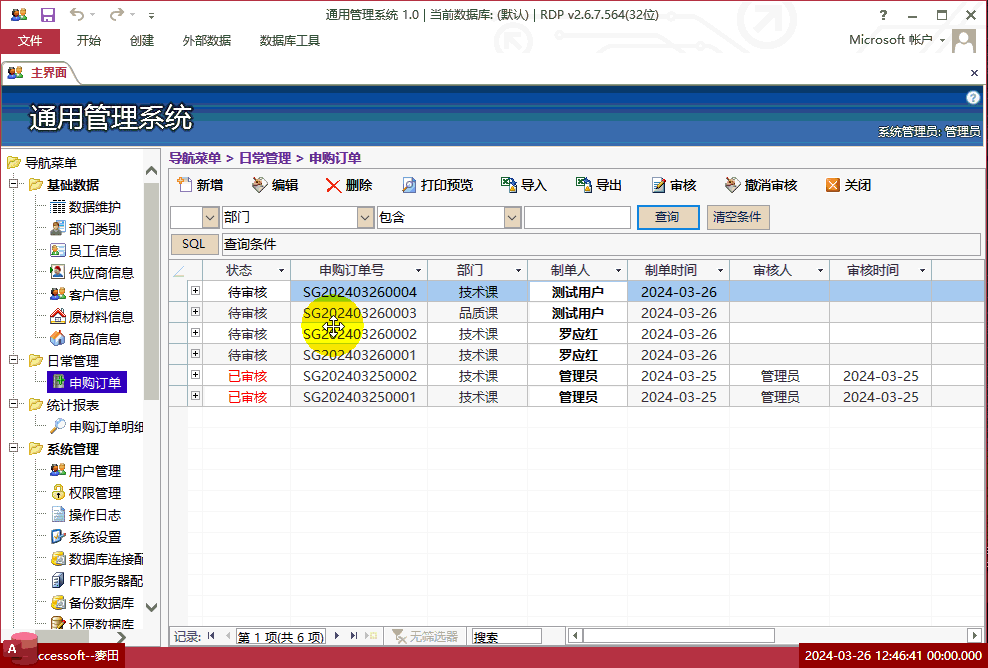access的真假:二、检查记录有无再insert 或 update 比 不管有无直接 delete 再 insert 快吗?
时 间:2009-09-10 09:55:49
作 者:ACMAIN_CHM ID:3535 城市:无锡
摘 要:检查记录有无再insert 或 update 比 不管有无直接 delete 再 insert 快?
正 文:
下面这个贴子中讨论了很多ACCESS中的一些猜想假设。
Access或其它数据库操作效率问题.欢迎讨论
http://topic.csdn.net/u/20090514/10/a93475bd-e67e-45c8-aa1e-87168ba36d02.html#replyachor
引用 9 楼 wwwwb 的回复::
你自己可以测试一下,不过根据经验,
DELETE,再INSERT(数据量比只插入没有的记录大 ) ,再建索引,速度比较慢。
比如表 table1 (id int primary key,cname varchar(10)
+----+-------+
| id | cname |
+----+-------+
| 1 | 1 |
| 2 | 2 |
| 3 | 3 |
| 4 | 4 |
| 5 | 5 |
| 6 | 6 |
| 7 | 7 |
| 8 | 8 |
| .. | ... |
+----+-------+
如果现在有一记录 (1234, 'KKKK'), 需要添加。那么两种方法。
方法一: 先做判断记录 1234是否存在,存在的话就 update table1 set cname = 'KKKK' where id=1234; 否则就 insert into table1 values(1234,'KKKK');
方法二: 不做任何判断,直接先 delete from table1 where id=1234; insert into table1 values(1234,'KKKK');
那么哪一种方法快?
在未做试验前,感觉上第二种方法,删除再添加记录应该是比较慢的一种。 但只是凭感觉,事实上是什么样呢,于是做了个简单的测试。
ACCESS 2003 SP3 + Windows 2000 SP4
新建一个空的t.mdb文件,然后建表 table1 (id int primary key,cname varchar(10)
新建一个模块,代码如下。
view plaincopy to clipboardprint?
Option Compare Database
Option Explicit
Public Sub tx()
Dim i As Integer
For i = 1 To 10000
CurrentProject.Connection.Execute "insert into table1 values(" & i & ",'" & i & "')"
Next
End Sub
Public Sub t1()
'CurrentProject.Connection.Execute "delete from table1 where id=1234"
Dim rs As New ADODB.Recordset
Dim ssql As String
ssql = "select * from table1 where id=1234"
rs.Open ssql, CurrentProject.Connection, adOpenStatic, adLockOptimistic
If rs.EOF Then
rs.AddNew
rs.Fields("id").Value = 1234
End If
rs.Fields("cname").Value = "KKK"
rs.Update
rs.Close
End Sub
Public Sub t2()
'CurrentProject.Connection.Execute "delete from table1 where id=1234"
Dim rs As New ADODB.Recordset
Dim ssql As String
ssql = "select * from table1 where id=1234"
rs.Open ssql, CurrentProject.Connection
If rs.EOF Then
ssql = "insert into table1 values(1234,'1234')"
Else
ssql = "update table1 set cname='1234' where id=1234"
End If
rs.Close
CurrentProject.Connection.Execute ssql
End Sub
Public Sub t3()
'CurrentProject.Connection.Execute "delete from table1 where id=1234"
Dim ssql As String
Dim nAffectedRow As Long
ssql = "update table1 set cname='1234' where id=1234"
CurrentProject.Connection.Execute ssql, nAffectedRow
If nAffectedRow = 0 Then
ssql = "insert into table1 values(1234,'1234')"
CurrentProject.Connection.Execute ssql, nAffectedRow
End If
End Sub
Public Sub t4()
'CurrentProject.Connection.Execute "delete from table1 where id=1234"
Dim ssql As String
ssql = "delete from table1 where id=1234"
CurrentProject.Connection.Execute ssql
ssql = "insert into table1 values(1234,'1234')"
CurrentProject.Connection.Execute ssql
End Sub
Public Sub t()
Dim i As Integer
Dim nCnt As Integer
nCnt = 5000
Debug.Print "t1 start.", Now
For i = 1 To nCnt
Call t1
Next i
Debug.Print "t1 end .", Now
Debug.Print "t2 start.", Now
For i = 1 To nCnt
Call t2
Next i
Debug.Print "t2 end .", Now
Debug.Print "t3 start.", Now
For i = 1 To nCnt
Call t3
Next i
Debug.Print "t3 end .", Now
Debug.Print "t4 start.", Now
For i = 1 To nCnt
Call t4
Next i
Debug.Print "t4 end .", Now
End Sub
Option Compare Database
Option Explicit
Public Sub tx()
Dim i As Integer
For i = 1 To 10000
CurrentProject.Connection.Execute "insert into table1 values(" & i & ",'" & i & "')"
Next
End Sub
Public Sub t1()
'CurrentProject.Connection.Execute "delete from table1 where id=1234"
Dim rs As New ADODB.Recordset
Dim ssql As String
ssql = "select * from table1 where id=1234"
rs.Open ssql, CurrentProject.Connection, adOpenStatic, adLockOptimistic
If rs.EOF Then
rs.AddNew
rs.Fields("id").Value = 1234
End If
rs.Fields("cname").Value = "KKK"
rs.Update
rs.Close
End Sub
Public Sub t2()
'CurrentProject.Connection.Execute "delete from table1 where id=1234"
Dim rs As New ADODB.Recordset
Dim ssql As String
ssql = "select * from table1 where id=1234"
rs.Open ssql, CurrentProject.Connection
If rs.EOF Then
ssql = "insert into table1 values(1234,'1234')"
Else
ssql = "update table1 set cname='1234' where id=1234"
End If
rs.Close
CurrentProject.Connection.Execute ssql
End Sub
Public Sub t3()
'CurrentProject.Connection.Execute "delete from table1 where id=1234"
Dim ssql As String
Dim nAffectedRow As Long
ssql = "update table1 set cname='1234' where id=1234"
CurrentProject.Connection.Execute ssql, nAffectedRow
If nAffectedRow = 0 Then
ssql = "insert into table1 values(1234,'1234')"
CurrentProject.Connection.Execute ssql, nAffectedRow
End If
End Sub
Public Sub t4()
'CurrentProject.Connection.Execute "delete from table1 where id=1234"
Dim ssql As String
ssql = "delete from table1 where id=1234"
CurrentProject.Connection.Execute ssql
ssql = "insert into table1 values(1234,'1234')"
CurrentProject.Connection.Execute ssql
End Sub
Public Sub t()
Dim i As Integer
Dim nCnt As Integer
nCnt = 5000
Debug.Print "t1 start.", Now
For i = 1 To nCnt
Call t1
Next i
Debug.Print "t1 end .", Now
Debug.Print "t2 start.", Now
For i = 1 To nCnt
Call t2
Next i
Debug.Print "t2 end .", Now
Debug.Print "t3 start.", Now
For i = 1 To nCnt
Call t3
Next i
Debug.Print "t3 end .", Now
Debug.Print "t4 start.", Now
For i = 1 To nCnt
Call t4
Next i
Debug.Print "t4 end .", Now
End Sub
结果很有趣。在把 'CurrentProject.Connection.Execute "delete from table1 where id=1234" 这一句注释的情况下,也就是表中存在该记录。需要进行更新。
表中记录已存在 测试结果:
t1 start. 5/14/2009 12:02:36 PM
t1 end . 5/14/2009 12:02:42 PM
t2 start. 5/14/2009 12:02:42 PM
t2 end . 5/14/2009 12:02:52 PM
t3 start. 5/14/2009 12:02:52 PM
t3 end . 5/14/2009 12:02:57 PM
t4 start. 5/14/2009 12:02:57 PM
t4 end . 5/14/2009 12:03:05 PM
把这个注释找开,即模拟记录不存在的情况。
表中记录不存在 测试结果:
t1 start. 5/14/2009 12:14:22 PM
t1 end . 5/14/2009 12:14:34 PM
t2 start. 5/14/2009 12:14:34 PM
t2 end . 5/14/2009 12:14:48 PM
t3 start. 5/14/2009 12:14:48 PM
t3 end . 5/14/2009 12:15:01 PM
t4 start. 5/14/2009 12:15:01 PM
t4 end . 5/14/2009 12:15:14 PM
在更新情况下各方法所耗时。t1: 6s t2: 10s t3: 5s t4: 8s
在插入情况下各方法所耗时。t1: 12s t2: 14s t3: 13s t4: 13s
结论
插入情况下各方法差不多
更新的情况下则差异比较大。方法二T4() 比 方法二T2() 快 20%
大家如果有兴趣,可以得用上面的代码,将初始化table1的代码更改一下,比较添加更多的记录到100,000级,或者添加更多的字段进行测试。 如有什么不同结果希望能反馈给我以对此试验进行补充修正。
Access软件网官方交流QQ群 (群号:54525238) Access源码网店
常见问答:
技术分类:
源码示例
- 【源码QQ群号19834647...(12.17)
- 用Access连续窗体制作的树...(11.03)
- 【Access高效办公】上一年...(10.30)
- Access制作的RGB转CM...(09.22)
- Access制作的RGB调色板...(09.15)
- Access制作的快速车牌输入...(09.13)
- 【Access高效办公】统计当...(06.30)
- 【Access高效办公】用复选...(06.24)
- 根据变化的日期来自动编号的示例...(06.20)
- 【Access高效办公】按日期...(06.12)

学习心得
最新文章
- Access快速开发平台--2.6...(12.24)
- Access快速开发平台企业版--...(12.10)
- SqlServer默认当前时间用什...(11.28)
- 【Access日期时间区间段查询示...(11.19)
- Microsoft Access不...(11.07)
- 用Access连续窗体制作的树菜单...(11.03)
- 【Access高效办公】上一年度累...(10.30)
- Access做的一个《中华经典论语...(10.25)
- Access快速开发平台--加载事...(10.20)
- 【Access有效性规则示例】两种...(10.10)




.gif)

